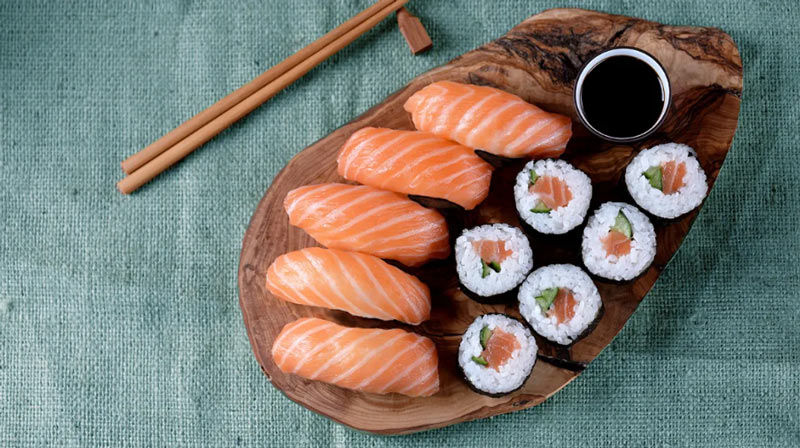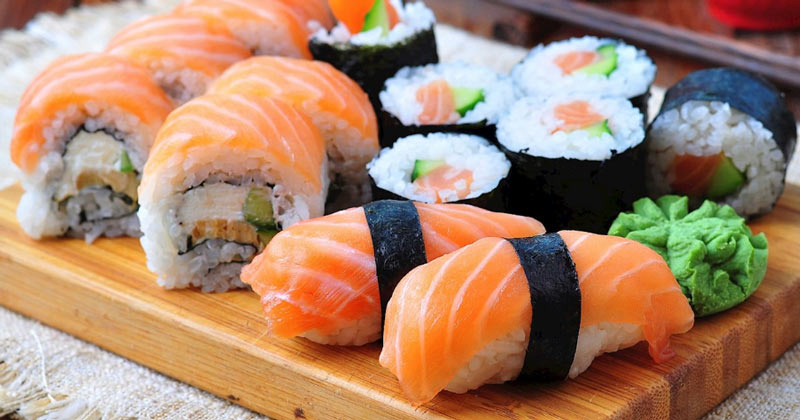Advertisement
Sushi vs. Sashimi
Oct 18, 2023 By Nancy Miller
When it comes to Japanese cuisine, nothing can beat sushi and sashimi. These two dishes have become a staple of many people’s diets worldwide because they are incredibly delicious, healthy, and easy to prepare. But what is the difference between them? In this blog post, we will explore how these two dishes differ in ingredients, preparation methods, nutritional values —and more—to help you make an informed decision when selecting your next Japanese dining experience.
What are Sushi and Sashimi?

Sushi and sashimi are staples of Japanese cuisine, but there is an important distinction between the two. While sushi refers to a combination of ingredients (including vinegared rice, vegetables, and seafood), sashimi refers only to thinly sliced raw fish or meat. The process of making sushi is also different from sashimi.
Sushi involves rolling the ingredients together with vinegared rice, while sashimi does not involve any rice in the preparation.
Sushi is often served with condiments, such as wasabi, ginger, and soy sauce, while sashimi is served with a light soy sauce. A common way to eat sashimi is to dip a piece of fish or meat into the soy sauce.
The most popular sushi type is nigiri, consisting of a slice of raw fish placed on top of hand-formed clumps of vinegared rice. Sashimi, on the other hand, is served in thin slices and does not require any additional ingredients.
Ingredients and how they’re made
Sushi and sashimi are made of similar ingredients, but the difference lies in how these ingredients are prepared. Sushi requires vinegared rice, which is cooked short-grain white rice mixed with a special vinegar blend.
The vinegar aids in the sushi's longer-term preservation. Sushi can include any mix of raw fish, cooked seafood, veggies, and occasionally eggs in addition to vinegared rice. Each component is divided into bite-sized bits before being rolled into a nori sheet, a thin sheet of seaweed. Wasabi and soy sauce are frequently added to sushi rolls to enhance the flavour.
Sashimi is made entirely from raw fish or other seafood, like squid or shrimp. The fish is sliced into thin pieces and decorated with condiments such as ginger, wasabi, and ponzu sauce. Sashimi contains no rice or other ingredients, so it’s a great option for those looking for a lower-calorie meal.
Both sushi and sashimi are popular Japanese dishes that can be enjoyed with friends or as part of a romantic dinner. Both dishes offer a variety of flavors and textures, so you’re sure to find something that suits your taste buds. Whichever dish you choose, make sure to enjoy it responsibly!
Nutritional differences between sushi and sashimi

Sushi and sashimi are popular dishes in Japanese cuisine, but the two have some key differences. Sushi combines vinegared rice with other ingredients such as raw fish, vegetables, or eggs. On the other hand, sashimi consists only of thin slices of raw seafood without any accompaniments.
Nutritionally speaking, sushi provides more calories per serving than sashimi. Sushi rice is high in carbohydrates, which makes it more calorie-dense than the protein-rich fish used for sashimi. Additionally, sushi often contains ingredients like mayonnaise and creamy sauces that can add to the calorie count. Even with a few extra calories, sushi can be healthier than other high-calorie dishes.
Sashimi is a healthy option for those looking to reduce calories, as the fish is low in fat and protein. It also contains important vitamins like A and D and omega-3 fatty acids, which help reduce inflammation.
Are there any downsides to eating sushi and sashimi?
While sushi and sashimi can be a healthy and delicious meals, there are some potential downsides that you should consider. Sushi tends to be higher in carbs since it is typically served with rice, so if you’re watching your carbohydrates or trying to lose weight, sushi may not be the best choice.
Additionally, because raw fish is used in sushi and sashimi, there are possible food safety risks if the fish is fresh and properly handled. Lastly, even though some types of sushi do not contain raw fish, they may contain other ingredients, such as cream cheese or mayonnaise, which are high in trans fats. It’s important to read labels carefully or ask your server about ingredients to make the healthiest choice possible.
Overall, sushi and sashimi can be an enjoyable part of a healthy diet, but it’s important to understand the potential risks associated with eating raw fish. Consider all options when deciding between sushi and sashimi - both offer delicious flavors that are sure to please anyone's palate.
Which Is More Nutritious? Sashimi Or Sushi?
When deciding which type of Japanese cuisine is more nutritious - sashimi or sushi - there are key differences to consider. Sushi typically involves cooked rice and vegetables rolled in nori, a Japanese seaweed wrap. This combination creates a delicious dish that is low in fat and high in carbohydrates.
On the other hand, sashimi typically consists of raw fish and sometimes vegetable garnishes. It is high in protein and healthy omega-3 fatty acids but contains no carbohydrates. Both dishes are a great choice for a balanced meal, but one may be more suitable depending on your individual dietary needs.
For example, sashimi may be the best option if you want a meal with higher protein and healthy fats. However, sushi may be the better choice if you want something with more carbohydrates to provide energy. Regardless of which option you choose, both are excellent sources of nutrition and can help you reach your dietary goals. Ultimately, choosing sashimi or sushi is a matter of personal preference.
Which Is Safer To Eat? Sashimi Or Sushi?
When it comes to deciding between sashimi and sushi, it is important to understand the differences between them. Sushi is a Japanese dish of cooked vinegared rice and other ingredients such as vegetables, raw fish, or shellfish. Sashimi, on the other hand, is slices of raw fish served without any accompaniments.
In terms of safety, both sashimi and sushi can be eaten safely if prepared with fresh ingredients and handled properly. Sushi is usually cooked, which eliminates potential foodborne pathogens.
However, if you prefer something other than cooked fish, sashimi may be the best option since it uses only raw fish. When deciding which is safer, the answer depends on where and how you consume them. If you are eating sushi or sashimi at a reputable restaurant, you can be sure it is safe to eat.
FAQs
Is sashimi real sushi?
Sashimi is a variety of sushi, yes. It is made out of thinly sliced raw fish or pork that is served with wasabi and soy sauce. Sashimi differs from sushi in that it is typically served without rice. Sashimi does not have vinegared rice, but sushi does.
Another distinction is that whereas sashimi lacks additional components like veggies, sushi frequently does. Sashimi is served as solitary slices, although sushi frequently incorporates some roll. In the end, both meals are delectable examples of traditional Japanese food.
Is sushi or sashimi better for you?
Both sushi and sashimi are healthy options. The fish is fresh. Sushi generally has fewer calories than sashimi because it contains rice, a carbohydrate source. As such, sushi may be a better option for those looking to watch their calorie intake. On the other hand, sashimi only contains raw fish and therefore has fewer carbohydrates.
Therefore, sashimi may be a better choice if you want to limit your carb intake. Regarding nutrition, sushi and sashimi can be healthy options if the fish is fresh and high-quality.
Why is sushi cheaper than sashimi?
Sushi is generally cheaper than sashimi because it includes a base of cooked rice. Sushi can also include other ingredients,s such as vegetables and sauces, which add to its cost. On the other hand, sashimi only consists of raw fish or meat, so it typically costs more. Additionally, sushi is often served with sides such as miso soup and pickled ginger, which can add to the cost of the dish.
Conclusion
This article has helped you understand the difference between sushi and sashimi. Sushi combines vinegared rice and other ingredients like vegetables, seafood, and sometimes meat.
On the other hand, sashimi is thinly sliced raw fish, or shellfish served without any rice. Both sushi and sashimi have unique flavors that make them delicious options. So if you need more clarification about what type of Japanese food to order, remember that sushi and sashimi are two distinct dishes.







